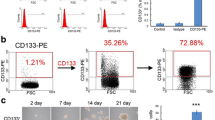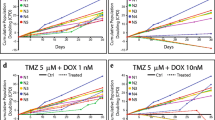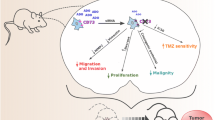Abstract
Because of the outstanding importance of the glucocorticoid Dexamethasone (DEX) as supportive therapy in the management of brain tumours, the direct effect of DEX on tumour cell proliferation is of particular interest. Previous in vitro studies led to contradictory results. To characterise more precisely the influence of DEX, we investigated the glioblastoma multiforme (GM) cell lines A172, T98G and 86HG39. Cells were treated with DEX concentrations ranging from 5 × 10−9 to 5 × 10−5 M from 24 to 240 h under different treatment conditions. Influence of DEX on glioma cell viability was assessed daily for 5 days by MTT-assay: (I) with continuous DEX incubation (acute treatment), (II) in a recultivation period without DEX after 5 days of DEX pre-incubation (pre-treatment), (III) with continuous DEX incubation after 5 days of DEX pre-incubation (combination treatment). DEX acute treatment led to strongly decreased proliferation of A172 cells, whereas T98G and 86HG39 cells remained uninfluenced. In opposite, a time-delayed inhibition of cell proliferation was observed in all three cell lines after DEX pre-treatment. Combination treatment induced a significant increase of the inhibitory effect in A172 and T98G cells. These data show a variable, partial time-dependent inhibitory effect of DEX on the proliferation of GM cells and may open new treatment strategies for malignant brain tumours.
Similar content being viewed by others
References
Kim TS, Halliday AL, Hedley-White ET, Convery K: Correlates of survival and the Daumas-Duport grading system for astrocytomas. J Neurosurg 74: 27–37, 1991
Koehler PJ: Use of corticosteroids in neuro-oncology. AntiCancer Drugs 6: 19–33, 1995
Grabb PA, Gilbert MR: Neoplastic and pharmacological influence on the permeability of an in vitro blood–brain barrier. J Neurosurg 82: 1053–1058, 1995
Kerr JFR, Winterford CM, Harmon BV: Apoptosis. Cancer 8: 2013–2022, 1994
Weller M, Schmidt C, Roth W, Dichgans J: Chemotherapy of malignant glioma: Prevention of efficacy by dexamethasone? Neurology 48: 1704–1709, 1997
Wolff JEA, Jürgens H: Dexamethasone induced partial resistance to methotrexate in C6 glioma cells. Anticancer Research 14: 1585–1588, 1994
Wolff JEA, Denecke J, Jürgens H: Dexamethasone induces partial resistance to cisplatinum in C6 glioma cells. Anticancer Research 16: 805–810, 1996
Wolff JE, Molenkamp G, Hotfilder M, Laterra J: Dexamethasone inhibits glioma-induced formation of capillary like structures in vitro and angiogenesis in vivo. Klin Padiatr 209(4): 275–277, 1997
Freshney RI, Sherry A, Hassanzadah M, Freshney M, Crilly P, Morgan D: Control of cell proliferation in human glioma by glucocorticoids. Br J Cancer 41(6): 857–866, 1980
Kawamura A, Tamaki N, Kokunai T: Effect of Dexamethasone on cell proliferation of neuroepithalial tumor cell lines. Neurol Med Chir (Tokyo) 38: 633–640, 1998
Mosman T: Rapid colorimetric assay for cellular growth and cytotoxicity assays. J Immunol Meth 65: 55–58, 1989
Hansen M, Nielsen SE, Berg K: Re-examination and further development of a precise and rapid dye method for measuring cell growth/cell kill. J Immunol Meth 119: 203–210, 1989
Gibelli N, Zibera C, Butti G, Assietti R, Sica G, Scerrati M, Iacopino F, Roselli R, Paoletti P, Robustelli della Cuna G, Rossi GF: Hormonal modulation of brain tumour growth: a cell culture study. Acta Neurochir (Wien) 101(3–4): 129–133, 1989
Becker PB, Gloss B, Schmid W: In vitro protein–DNAinter actions in a glucocorticoid response require the presence of the hormone. Nature 324: 686–688, 1986
Ellemann K, Christensen L, Gjerris F, Briand P, Kruse-Larsen C: Glucocorticoid receptors in glioblastoma multiforme: a new approach to antineoplastic glucocorticoid therapy. Acta Neurochir 93: 6–9, 1988
Rieger J, Durka S, Streffer J, Dichgans J, Weller M: Gemcitabine cytotoxity of human malignant glioma cells: modulation by antioxidants, BCL-2 and dexamethasone. Euro J Pharmacol 365: 301–308, 1999
Brake PB, Zhang L, Jefcoate CR: Aryl hydrocarbon receptor regulation of Cytochrome P4501B1 in rat mammary fibroblasts: evidence for transcriptional repression by glucocorticoids. Mol Pharmacol 54(5): 825–833, 1998
Author information
Authors and Affiliations
Rights and permissions
About this article
Cite this article
Kaup, B., Schindler, I., Knüpfer, H. et al. Time-dependent Inhibition of Glioblastoma Cell Proliferation by Dexamethasone. J Neurooncol 51, 105–110 (2001). https://doi.org/10.1023/A:1010684921099
Issue Date:
DOI: https://doi.org/10.1023/A:1010684921099




